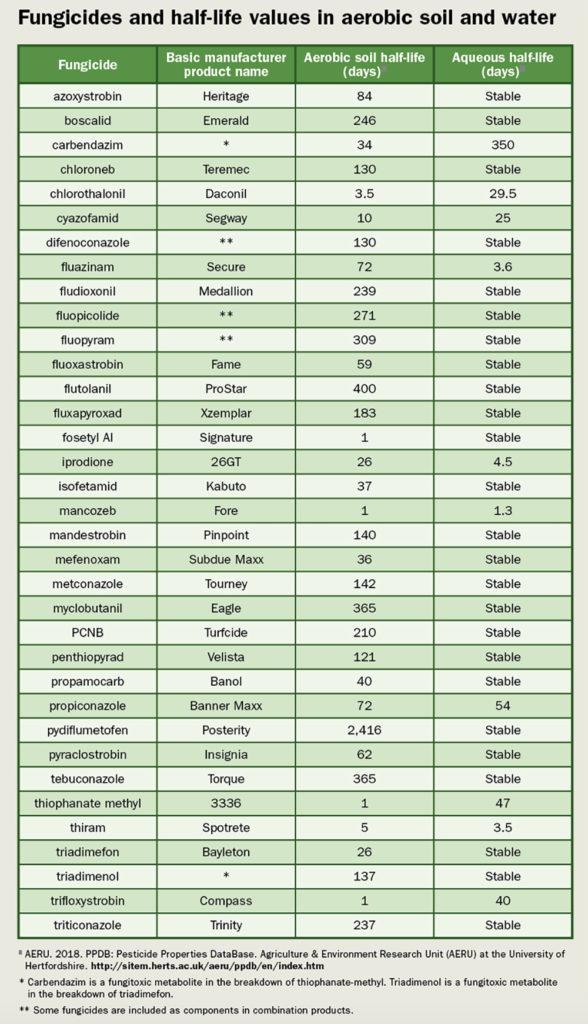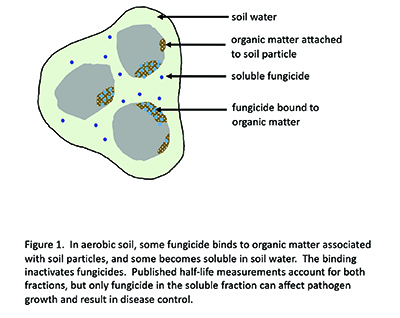Half-life is not the whole story
There’s been a fair amount of chatter lately about fungicide half-life and what it means for disease control and fungicide resistance risk. Half-life is the time required for a substance to be broken down into half the original amount. It is a measure of its persistence in the environment.
Table 1 includes published half-life estimates for selected fungicides in aerobic soil and water. Half-life in soil and water are not related, and they impact different segments of a product’s journey from the package to the turf surface.
Half-life in water is relevant to fungicide stability in the spray tank and may be influenced by water quality. Breakdown in the spray tank often is associated with high pH (alkaline hydrolysis). The bottom line is that alkaline hydrolysis is not an issue with most modern fungicides (they are listed as “stable” in Table 1). For those few fungicides where it may be a concern, the hydrolysis acts on only the small soluble fraction of fungicide.
Half-life in aerobic soil is pertinent to fungicide behavior within the turf profile. Here is where mistaken assumptions may lead to unreasonable expectations regarding fungicide performance. If a fungicide has a long half-life, should superintendents expect extended periods of disease control? Does a greater soil half-life value mean that pathogen populations will be exposed to the active ingredient for a longer period of time, and therefore, is there increased selection pressure for fungicide-resistant strains? Explanations to these questions are based on how half-life is defined and the very nature of the degradation process.
What a lab says
Half-life is determined in the laboratory by adding fungicide to soil then sampling repeatedly over time. The labs use concentrated solvents to pry every last bit of fungicide from each sample. When 50 percent of the original concentration remains, the lab records half-life. The procedure is relevant to this discussion because not all fungicide detected by laboratory extraction and analysis is accessible in nature by plants and microbes. Once a fungicide finds its way into the soil, some of it remains soluble in the soil water, and some of it binds to organic matter attached to soil particles (Figure 1). The fraction that binds is rendered inactive; it will not affect pathogen growth and will have little or no disease-control capability. The extent of binding is influenced by fungicide attributes and soil properties (more binding occurs where organic matter is high) and tends to strengthen over time. Recorded half-life values like those in Table 1 account for total fungicide, both soluble and bound fractions.
For purposes of disease control, only the amount of fungicide in the soluble fraction is important. The soluble fraction is available to plants and soil microbes, including fungal pathogens. Fungicide in both fractions is subject to breakdown by a combination of physical, chemical and biological forces. Microbial transformation — the breakdown of organic molecules into components utilized for microbial growth — is required for complete degradation of a fungicide into its basic elements.
Possible overestimation
When interpreted from the perspectives of fungicide efficacy and disease control, published half-life values tend to overestimate the duration of the fungicide’s useful presence in the turf profile.
Consider tebuconazole, a popular modern DMI fungicide with activity against a broad spectrum of turf pathogens. The estimated half-life of tebuconazole in aerobic soil is 365 days (Table 1). Yet, as effective as it is, superintendents would not expect disease control for a full year, even if they doubled the tebuconazole application rate. That’s because its recorded half-life value represents total fungicide, both soluble and bound fractions. Therefore, despite the fact that its published half-life is 365 days, tebuconazole’s “efficacy” half-life is so much shorter.
Efficacy half-life is the time required for efficacy of a given fungicide to be degraded to half that of the original treatment. There are no published standards for efficacy half-life, and it will vary with the fungicide application rate and other factors. However, based on observations of residual disease control with tebuconazole and most other fungicides, efficacy half-life is much closer to a week than a year. Also, since bound fungicide fractions have no inhibitory effect on pathogen growth, the long half-life for tebuconazole (and similar fungicides) does not increase fungicide resistance risk.
What else to watch
Other issues complicate the discussion. Fungicide breakdown is a process involving a sequence of steps starting with the active ingredient molecule, then passing through a series of (mostly nonfungitoxic) metabolites before complete degradation to CO2, H2O and inorganic constituents (chlorine, sulfur, nitrogen, etc.).
A few fungicides have breakdown metabolites that are fungitoxic. In the world of turf fungicides, carbendazim and triadimenol are fungitoxic metabolites in the degradation of thiophanate-methyl and triadimefon, respectively. So, while the original active ingredients may not be detected in a sample, metabolites will continue to inhibit fungal growth. Research suggests that such metabolites are short-lived and do not contribute much to overall treatment efficacy.
Also, published half-life estimates differ depending on testing methodology. Because of refinements in procedures and instrumentation, values published in 2000 can differ substantially from values determined 15 years later. Half-life values sometimes are expressed as a range to reflect environmental variables that influence persistence over time. Finally, a small portion of fungicide bound in the turf profile may become unbound (desorbed) over time as microbes digest organic matter. Researchers have completed little desorption research with fungicides, but results of studies in bioremediation of other pesticide pollutants suggest that it has negligible practical value.
Looking more closely
It’s a good thing superintendents and other turf professionals are discussing fungicides more deeply than merely what and when to spray. Understanding how and why fungicides work is essential to making decisions from an informed perspective.
However, there usually are no simple explanations for fungicide behavior in the turf profile. Interpretations of fungicide half-life based on partial understanding rarely tell the whole story. The take-home message distills down to two points: Long half-life values do not translate to extended periods of disease control, and they do not suggest increased risk for the development of fungicide-resistant pathogen populations.
Rick Latin, Ph.D., is a professor emeritus of Plant Pathology at Purdue University, where he conducted extensive research on all aspects of turfgrass disease management and control. You may reach Rick at rick@rlturf.com for more information.
References
Hanson, B.; Bond, C.; Buhl, K.; Stone, D. 2015. Pesticide Half-life Fact Sheet; National Pesticide Information Center, Oregon State University Extension Services. http://npic.orst.edu/factsheets/half-life.html.
AERU. 2018. PPDB: Pesticide Properties DataBase. The PPDB. Agriculture & Environment Research Unit (AERU) at the University of Hertfordshire. http://sitem.herts.ac.uk/aeru/ppdb/en/index.htm (accessed 1 March 2019).












